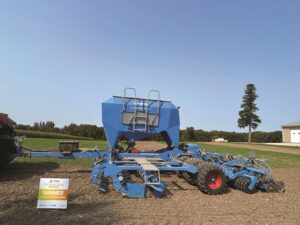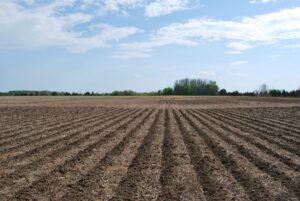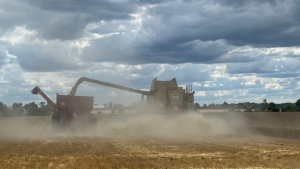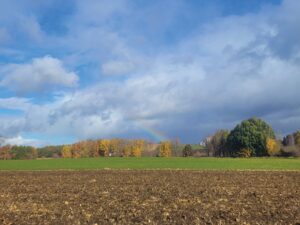More reason to believe in winter wheat
The grain’s performance as a cover crop adds to its value
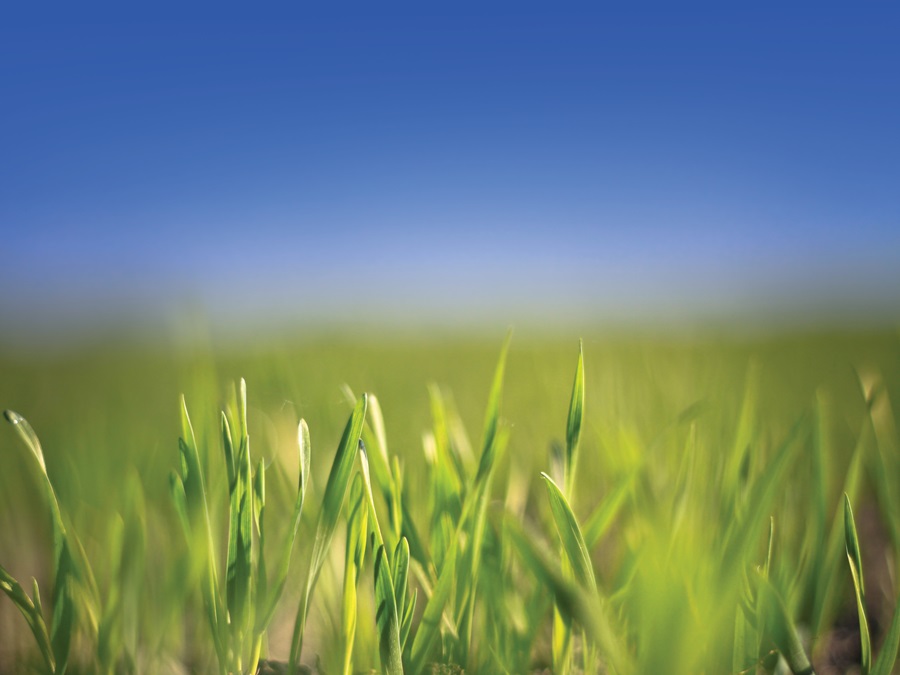
One thing about the world of science is that no matter how “settled” an issue may seem, there is always room for more study or scrutiny. Some other facets can be redefined or measured with a different set of criteria.
WHAT’S IN A NAME?
Should we call winter wheat a cover crop? Given that winter wheat has so many environmental benefits, akin to a cover crop, should it be classified as such? According to Mohammed, the term ‘cover crop’ serves a precise purpose—it defines a class of plants grown with the sole intent of protecting and enhancing the soil, independent of market return. If we begin including harvested crops in this definition, we risk eroding the usefulness of the cover crop term and causing confusion. That said, this study allows us to make the case that winter wheat has all of the environmental benefits of a cover crop, plus economic benefits, putting it into a class of its own. And when we advocate for governments and customers to provide winter wheat with the same regard and support as cover crops, we’re making that case very clearly.
Such is the case with a literature review concerning the implementation of winter wheat in Ontario crop rotations, attempting to determine its economic viability and environmental resilience as a grain crop. The review was conducted by five University of Guelph students and drew on peer-reviewed literature, Canadian publications, Government of Ontario resources, and material from Grain Farmers of Ontario.
In a subtle twist on previous research examining winter wheat in rotations, the fourth-year students, Andrea Kolodziej, Madeline Killen, Chelsea Uusitalo, Julia Perucelli, and Ria Hamilton, sought to reveal the benefits of winter wheat as a cover crop first and a grain crop second. Titled “A Critical Review of the Potential of Winter Wheat as a Tool for Enhancing Sustainability and Profitability of Grain Production in Ontario,” the project was carried out in partnership with Grain Farmers of Ontario and coordinated through Ibrahim Mohammed, Grain Farmers of Ontario’s sustainability and environment specialist.
WHAT THE NUMBERS SAY
The statistics for winter wheat production in Ontario indicate an increased value in the crop on its own. In the past five years, wheat yields have averaged 93.1 bushels/acre, while acreages planted and harvested have averaged more than 1.0 million acres. Estimates for the 2025 winter wheat crop were 1.184 million acres.
Research into lengthening crop rotations began in 1980 with Dr. Bill Deen at the University of Guelph’s Elora Research Station. Eight rotations were studied, including two with winter wheat. In 1995, Doug Young began work on the long-term effects of maintaining winter wheat at what was then Ridgetown College of Agricultural Technology (RCAT). That work was succeeded by Dr. Dave Hooker at the University of Guelph’s Ridgetown Campus. Although their treatments varied (including underseeding with red clover in 2010), the work determined that winter wheat boosted yields in subsequent corn and soybean crops and reduced the reliance on nitrogen-based fertilizer.
This latest report aims to provide insights into the role of winter wheat as a cover crop, an interesting twist on research into the effects of lengthening rotations. An added focus is its potential effect on improving soil health, reducing soil erosion, and enhancing the carbon content in the soil.
“Winter wheat isn’t normally considered a cover crop and is mainly used for its (grain) crop qualities,” says Andrea Kolodziej, speaking on behalf of the students involved in the review. “Within our research, we wanted to show that it has the same benefits as conventional cover crops while also being able to be used as a (grain) crop. This allows winter wheat to have increased benefits while it’s being used in rotation with corn and soybeans.”
THE PROCESS
The students pursued a systematic review of studies from a variety of databases, including Google Scholar and Ag Data Commons, among several others. Studies were chosen if they contained information on five key points:
- how winter wheat improves soil health
- how it compares to other cover crops
- evaluation of its economic benefits
- economic factors that might affect its adoption
- possible incentives or policies that are recommended
The group enlisted the help of Dr. Helen Booker, who holds the Grain Farmers of Ontario Professorship in Wheat Breeding, and Dr. Vern Osborne, a retired professor of animal and poultry science.
RESULTS
First on the list of findings was the effects on nitrogen, which were shown to increase nitrogen uptake within the soil profile, with some studies citing up to 67 per cent reduced leaching compared to conventional rotations without cover crops. Those effectively scavenge excess nitrogen within the profile and can reduce leaching and runoff. Winter wheat also supports microbial populations, which also help regulate excess nitrogen levels. The more resilient a microbial community, the stronger the nutrient cycling potential, particularly nitrogen cycling, resulting in reduced nitrogen losses to leaching and minimized nitrous oxide (N2O) levels.
From an erosion perspective, cover crops increase the amount of ground cover days thereby reducing the risk of soil loss through wind and water erosion. The project found that incorporating winter wheat into a corn-soy rotation can increase the effective soil cover days from 70 per cent to about 91 per cent. And with this comes a substantial reduction in erosion risk, especially water erosion in the spring. Winter wheat can also improve soil structure and reduce erosion by boosting soil organic matter, thus enhancing structure and leading to aggregation and making infiltration more efficient. That leads to improved soil health via soil stability and adding biomass that adds essential nutrients to the soil.
Since carbon emissions are a concern within agriculture and plants sequester carbon via photosynthesis, any increase in the number of plant cover days enhances carbon uptake and can potentially offset carbon emissions.
“Winter wheat can act as a carbon source and sink for the soil,” says Kolodziej. “The ability to sequester carbon can help reduce atmospheric carbon dioxide concentrations. Winter wheat is also grown at a time of year in Ontario that has a reduction of carbon-sequestering vegetation. It can help reduce carbon dioxide concentrations in the atmosphere at a time when an increased concentration normally occurs.”
The difference in conventional rotations is viewing winter wheat only as a grain crop. Kolodziej and her colleagues wanted to show it could provide the same benefits to a cropping system as a cover crop with an added benefit as a grain crop.
“We think that if there are resources and incentives available to farmers for new implementation of crop alternatives, they would be open to implementation,” she says. “Adding a new crop into the rotation or changing a rotation isn’t a simple process. There are many factors to be taken into account that vary from farm to farm due to different environmental and economic factors that can affect the addition of a new crop and the feasibility of changing a rotation.”
FROM THE GROWER’S PERSPECTIVE
The prospect for growing winter wheat—whether as a grain crop or a cover crop that can also be harvested and sold—is largely linked to revenue generation and profitability, at least it is for Jeff Barlow. Although he grows a three-crop rotation of corn, soybeans and winter wheat on his farm near Binbrook, south of Hamilton, he echoes Kolodziej’s comment about the economics that go into most decision-making processes on the farm.
“If winter wheat prices were higher, everyone would be growing more,” adds Barlow, who’s also director for Grain Farmers of Ontario District 6 (Haldimand, Brant, Hamilton, Niagara). “Lately, we’ve had very open falls and plenty of opportunity to plant winter wheat in decent conditions. In my area on heavier clay, it’s tougher to make wheat work in a lot of years. It’s not hard to establish in the fall, it’s getting it through the winter and have it still be alive in the spring.”
Barlow agrees that winter wheat makes for an excellent cover crop, given its seed price, its ability to grow in 7.5-inch rows, and its root structure. For those reasons—and the impact on subsequent corn or soybean crops—it’s an excellent cover crop. At the same time, he acknowledges that on tougher clay in his immediate area, establishing winter wheat crops in anything but the best of fall planting conditions can be a big ask.
From a logistics perspective, winter wheat allows him the opportunity to fix-up the field after harvest; he can do more tiling, repair ditches, trim trees along fields, do soil tests, and apply fertilizer. That he can do that with a cover crop that’s also marketable is a huge bonus— along with the other agronomic, soil health, and environmental benefits.
“With sustainability, it’s certainly good for the soil, so if keeping the soil green is good for the environment, then it’s really good,” says Barlow. “I also like winter wheat because I underseed it with red clover every year, which adds another cover crop that will continue to keep the field green after the wheat comes off. It does a lot of good for the soil and makes nitrogen for next year’s crop.”
As for whether this review can help boost the number of winter wheat acres in Ontario, Barlow again points to the economics: if wheat prices were $8 to $10 per bushel, it might be different.
“I still think farmers know best,” he says. “We’re all trying to do our best for the environment and the best for our businesses, which, for the most part, are the same thing. Whatever we’re doing to get better yields is making the soil and the environment better.”
IN CONCLUSION
“Winter wheat has a tremendously balanced impact across the three dimensions of agricultural sustainability, Environmental, Economic, and Social,” says Mohammed. “Including it in the rotation is one of the most efficient ways to enhance the sustainability of grain production in Ontario.”
Mohammed says that the environmental benefits of including winter wheat in the rotation is especially evident in Ontario, where spring storms are common. Having an established crop in the field during that period can help reduce the incidence of erosion.
And from an economic sustainability standpoint, Mohammed points out that while the revenue tradeoff from growing winter wheat may not be immediately obvious, this highlights the need for incentives to encourage its inclusion in rotation systems. Doing so helps maintain the environmental benefits. Winter wheat also increases residue quality residue in rotation, which supports soil carbon sequestration—a key climate mitigation strategy.
“This makes a strong case for promoting winter wheat as a climate- smart practice that benefits both farmers and the environment and should be considered in investment programs that support the adoption of sustainable farming practices,” concludes Mohammed. •












